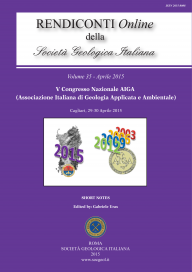
Recharge in karst aquifers: from regional to local and annual to episodic scale
Ferdinando Manna (a), John R. Nimmo (b), Vincenzo Allocca (a) & Pantaleone De Vita (a)
(a) Department of Earth Science, Environment and Resources - University of Naples Federico II. E-mail: ferdinando.manna@unina.it
(b) United States Geological Survey – Menlo Park (CA)
Volume: 35/2015
Pages: 196-199
Abstract
The assessment of groundwater recharge for karst aquifers of southern Italy is a major scientific task due to the relevant socio-economic and environmental role of the related groundwater resources. In this paper, the results of two methods, applied at different spatial and time scales, are reported.
At regional and mean annual scales, through a multidisciplinary approach, the mean Annual Groudwater Recharge Coefficient (AGRC) was estimated for four sample karst aquifers, with available long-lasting spring discharge time series. Such estimations were extended to other karst aquifers of southern Italy by means of an empirical law that was found linking the AGRC to percentages of outcropping lithologies and endorheic/summit plateau areas.
At local and episodic scales, the groundwater recharge of a test perched karst aquifer, belonging to the Mount Terminio hydrogeological structure (Campania region, southern Italy) was estimated. For such a purpose, an improvement of the Water Table Fluctuation (WTF) method, known as Episodic Master Recession (EMR), was applied to estimate the Recharge to Precipitation Ratio (RPR) coefficient, which represents the amount of precipitation recharging groundwater.
Results obtained through the first approach furnished AGRC values varying between 50% and 79% and well matching with estimations of infiltration coefficients known in literature for other karst aquifers of Europe. Moreover, the mean value of RPR determined for the local karst aquifer (73%) resulted well matching with the AGRC estimated for the whole Mount Terminio karst aquifer (79%).
By the comparison of these outcomes, at the regional and mean annual scales, the groundwater recharge of karst aquifers was found as mainly controlled by both the extension of outcropping lithologies and endorheic/summit plateau zones. While at the local and episodic scales, the groundwater recharge was recognized as chiefly influenced by the rainfall intensity and soil hydrological condition.
Keywords
Get Full Text